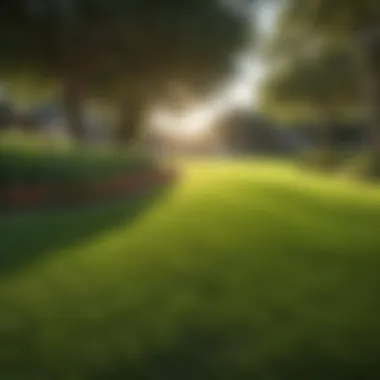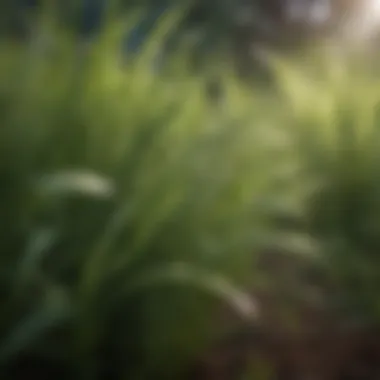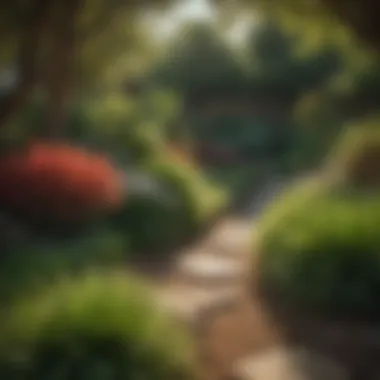Top Shade-Tolerant Grasses for North Texas Lawns


Overview of the Topic
Definition and Importance
Shade-tolerant grasses are varieties that can thrive in low-light conditions. In North Texas, where shade can be prevalent due to tree canopies and building structures, understanding which grass types are best suited for these conditions is crucial. Selecting the right grass is not only important for aesthetic reasons but also for maintaining the ecological balance of the lawn. Healthy grass ensures proper soil retention, water absorption, and supports local wildlife.
Current Trends
In recent years, awareness has grown regarding the impact of urban development on green spaces. With increasing shade in residential and commercial areas, gardeners are seeking sustainable solutions. Consequently, there is a trend toward using native and drought-resistant grasses that not only tolerate shade but also require less water and maintenance. This shift reflects a broader movement towards environmentally friendly gardening practices.
Key Techniques and Practices
Step-by-Step Guide
- Assess Shade Levels: Measure the amount of shade present. Identify areas with varying degrees of light exposure; separates full shade from partial shade.
- Select Appropriate Grasses: Some of the leading options include:
- Soil Preparation: Ensure the soil is well-aerated and nutrient-rich. Incorporate organic matter like compost to boost fertility.
- Sowing or Sprigging: Choose the appropriate method based on the grass type. Follow the recommended seed rates for better results.
- Watering and Maintenance: Keep the soil moist during the germination period. Once established, adjust watering schedules based on the season.
- Evaluate and Adapt: Monitor growth and make necessary adjustments. If certain areas struggle, consider alternative grasses or improvements to soil and drainage.
- Zoysia Grass: Very versatile and can handle a range of conditions.
- Fescue Grass: Known for its fine texture and ability to withstand shade.
- Buffalo Grass: A drought-resistant option that can tolerate some shadow.
Tools and Equipment Needed
- Lawn mower
- Soil test kit
- Aerator
- Compost or organic fertilizer
- Seed or sprigs of selected grass types
- Watering system or hose
Challenges and Solutions
Common Obstacles
Adapting grasses to shade can come with difficulties. Some common problems include:
- Insufficient light leading to poor growth.
- Soil compaction affecting root development.
- Competition from tree roots for nutrients and water.
Innovative Solutions
To overcome these challenges, consider:
- Improving light filtration by selectively pruning tree branches.
- Regular aeration of the soil to maintain healthy root systems.
- Implementing a mulch layer to help retain moisture and suppress weeds.
"Choosing the right shade-tolerant grass requires understanding both the environmental conditions and the unique characteristics of each grass variety."
In summary, growing a healthy lawn with shade-tolerant grass in North Texas is both an art and a science. With careful selection and management, homeowners and gardening enthusiasts can create lush green spaces even in low-light environments.
Intro to Shade Tolerant Grass
Shade-tolerant grass plays a critical role in maintaining the aesthetics and health of lawns, particularly in regions like North Texas, where intense sunlight and heat can challenge growth in shaded areas. Understanding the importance of selecting appropriate grass varieties for these areas will help homeowners and agricultural enthusiasts create lush, green spaces.
When grass receives insufficient sunlight, it struggles to thrive, leading to thinning patches and unsightly colors. Shade tolerance becomes essential, as it allows grass to adapt to environments with limited direct sunlight. Furthermore, considering shade tolerance fosters biodiversity in local ecosystems, which can contribute positively to the overall health of the environment.
Understanding the Need for Shade Tolerance
As urbanization expands in North Texas, more properties are created with trees and structures that provide shade over lawns. Homeowners may find that their once sunny yards are now partially or fully shaded. Given that many common grass types struggle to grow in low-light conditions, the need for shade-tolerant varieties emerges more sharply.
Emphasizing grass selections that thrive under these conditions means not only keeping lawns looking attractive but also reducing maintenance effort and costs. The choice of shade-tolerant grass helps maintain soil health and prevents erosion in shaded areas, enhancing the overall functionality of the landscape.
Climatic Considerations in North Texas
North Texas experiences a unique climate characterized by hot summers and mild winters. This climate can lead to increased stress on grasses, particularly in shaded regions. The high temperatures can encourage certain diseases while creating uneven moisture levels that affect grass health.
In these conditions, choosing the right grass becomes even more crucial. Grass varieties that not only exhibit shade tolerance but are also resilient to heat and drought are ideal for this region. Understanding local climatic conditions helps guide decisions on which grass types will perform best, thus ensuring a thriving lawn that is both beautiful and sustainable.
Characteristics of Shade Tolerant Grass
Understanding the characteristics of shade tolerant grass is essential for anyone looking to cultivate a lush and healthy lawn in North Texas. The unique climatic conditions of this region necessitate a careful selection of grass types that can thrive in less favorable light settings. This section provides an in-depth analysis of shade tolerance, growth patterns, and nutrient needs to help you make informed decisions for your shady lawn.


Defining Shade Tolerance
Shade tolerance refers to a grass's ability to adapt and grow in environments with limited sunlight. It is crucial because not all grass types can survive in shaded areas. Grasses that exhibit shade tolerance possess specific traits that allow them to efficiently carry out photosynthesis under low light conditions. This includes broader leaves that capture light effectively and a slower growth rate which reduces competition for nutrients and moisture.
The importance of shade tolerance becomes apparent in North Texas, where trees and structures often obstruct sunlight. Knowing the shade tolerance of different grass species is important; as some can handle partial shade, while others may require more light for optimal growth.
Growth Patterns in Shaded Areas
In shaded areas, the growth patterns of grass are distinct from those in full sunlight. Shade tolerant grasses generally develop differently, with an emphasis on maximizing light absorption. These grasses tend to grow taller and stretch toward available light, leading to a more vertical growth habit. Additionally, they may produce less biomass compared to their sun-loving counterparts, which helps conserve energy and resources in low-light environments.
These adaptations are necessary to ensure survival in shaded environments. Grass species that cannot adapt to these conditions often experience stunted growth or die off entirely. Therefore, understanding the growth patterns can help gardeners manage their lawns better, ensuring adequate space and resources are available for healthy development.
Nutrient Requirements
Nutrient management for shade tolerant grasses is crucial. These grasses often require different nutrient ratios compared to those grown in full sunlight. For example, shade tolerant varieties typically need less nitrogen, as they are not growing as vigorously. Instead, maintaining the right phosphorus and potassium levels becomes more important in shady areas to support root development and overall health.
Regular soil testing can help identify nutrient deficiencies. Corrective measures can then be made, such as applying fertilizer specifically formulated for shady conditions. A balanced approach to fertilization not only promotes healthy growth but also minimizes the risk of over-fertilization, which can lead to disease and pest problems. This knowledge is essential for maintaining a resilient lawn in the shaded regions of North Texas.
"Choosing the right grass variety is fundamental for success in shaded areas. Understanding their specific physiological needs is key to promoting a healthy, sustainable lawn."
In summary, the characteristics that define shade tolerant grasses establish a framework for successful lawn care in North Texas. Through understanding shade tolerance, growth patterns, and nutrient requirements, gardeners can make informed choices that lead to a thriving green space.
Popular Shade Tolerant Grass Varieties for North Texas
Selecting the proper grass type for shaded areas in North Texas is crucial for achieving a health lawn. Shade-tolerant grass varieties can help homeowners and gardeners maintain their aesthetics and functionality. This section highlights the significance of choosing the right grass and examines various popular options, emphasizing their unique characteristics, advantages, and considerations for North Texas.
Buffalo Grass
Description and Features
Buffalo grass is a native variety well-suited for North Texas. One key characteristic of Buffalo grass is its drought resistance. This quality enables it to thrive in areas with reduced water availability. Its fine texture and low growth habit contribute to its appeal, making it a desirable option for both residential and commercial lawns.
A unique feature of Buffalo grass is its ability to adapt to various soil types. Whether sandy or clay, this grass can establish well, providing a viable option for diverse landscapes. However, it may not perform optimally in excessively moist conditions, requiring attention in areas prone to flooding.
Optimal Conditions
Buffalo grass prefers full sun but can tolerate some shade. Ideal conditions include well-drained soil and limited competition from other plants. This tolerance to partial shade makes it a suitable choice for lawns receiving filtered sunlight from overhanging trees or structures.
The advantageous aspect of Buffalo grass is its low maintenance requirements. Once established, it requires minimal mowing and fertilization. However, it should be noted that this variety may struggle in heavily shaded areas, particularly those lacking adequate sunlight.
Maintenance Guidelines
For optimal growth, Buffalo grass should be mowed to a height of about two to three inches. It is essential to avoid cutting it too short to prevent stress during hot months. Watering practices should be adjusted according to rainfall; this grass requires less frequent watering compared to other types. Fertilization should occur sparingly, ideally using a slow-release fertilizer to sustain its health without promoting excessive growth.
Zoysia Grass
Advantages in Shade
Zoysia grass is another popular choice known for its resilience in shaded environments. One significant advantage of Zoysia is its ability to survive in lower light conditions. This quality allows it to flourish under trees or near buildings that cast shadows.
The unique characteristic of Zoysia grass is its thick, insulating growth. This trait not only contributes to its shade tolerance but also enhances its durability against foot traffic. While Zoysia may take longer to establish compared to other grasses, its longevity and low maintenance needs make it a worthy investment for shaded lawns.
Growth and Care
Zoysia grass displays a slower growth rate during the early stages. However, once fully established, it spreads aggressively. Proper care involves infrequent mowing and a balanced watering schedule. During periods of drought, Zoysia's deep root system helps it conserve moisture, making it an excellent choice for areas with limited water access.
The grass performs best in well-draining soils with adequate nutrients. Though not overly demanding, regular aeration can improve growth, particularly in compacted soils.
Suitability for North Texas
Zoysia grass is particularly suitable for North Texas due to its heat tolerance. It can withstand the region's high temperatures during summer while also managing shaded conditions effectively. The prolonged growing season provides ample time for Zoysia to establish, leading to resilient lawns capable of enduring environmental stressors.
Fescue Grass


Types of Fescue
Fescue grass encompasses various types, with tall fescue being the most notable for shaded areas. One key characteristic of tall fescue is its deep root structure. This quality not only enhances drought resistance but also promotes stability in the soil.
A unique feature of fescue is its adaptability to different climates. While this grass thrives in cool seasons, it can withstand temperature fluctuations, making it suitable for North Texas.
Best Practices for Growth
For optimal growth, Fescue grass requires regular watering, especially during dry spells. Implementing a balanced fertilization schedule will enhance its resilience. It is ideal to mow fescue to a height of about three to four inches. This also helps retain moisture and reduces stress during summer.
Avoiding competition with weeds is crucial as it can affect growth. Regularly identify and manage weeds to ensure fescue can thrive in shaded areas.
Ideal Soil Conditions
Fescue grass prefers alkaline soils with good drainage. However, it can thrive in a variety of soil types. Regular soil testing can ensure appropriate nutrient levels, which is essential for robust growth. In acidic soils, amendments may be necessary to support optimal conditions.
Bermudagrass
Growth Characteristics
Bermudagrass is well-regarded for its fast-growing nature. Its growth characteristics make it an excellent option for homeowners looking for quick results. One key aspect to note is its ability to recover swiftly from damage. This resilience is beneficial for high-traffic areas.
Bermudagrass does well in sunny areas but can adapt to lighter shade conditions. Nevertheless, it may not be the best choice for deeply shaded spots. The grass can become thin and stressed when deprived of sunlight.
Place in Shade
While Bermudagrass prefers full sun, it can grow in dappled shade. However, it is vital to monitor its health in such conditions. In prolonged shady environments, it may exhibit slow growth rates, suggesting the need for an alternative grass type.
A unique feature of Bermudagrass is its low establishment cost and ease of propagation. It can spread quickly through seed or sod, making it popular for those looking for a lush lawn in a short time.
Care and Fertilization
Bermudagrass requires regular mowing at a height of about one to two inches. Consistent watering and adequate fertilization promote vigorous growth. Opt for nitrogen-rich fertilizers to support a healthy lawn.
In terms of care, it is important to reduce the frequency of watering during cooler months as overwatering can lead to diseases. Overall, Bermudagrass needs diligent maintenance to remain healthy and vibrant in shaded areas.
Best Practices for Growing Grass in the Shade
Growing grass in shaded areas of North Texas presents unique challenges. However, implementing best practices is essential for fostering a healthy lawn. Shade can restrict sunlight, hinder growth, and make grasses susceptible to pests and diseases. Therefore, understanding how to manage soil, water, and nutrients in shaded conditions is crucial for achieving vibrant grass.
Soil Preparation
Soil preparation is the first step towards successful grass growth in shaded areas. The right soil conditions enhance root development and nutrient absorption. Begin by testing the soil pH, aiming for a range between 6.0 and 7.0, which is ideal for many shade-tolerant grasses. If the soil is too acidic or alkaline, amendments such as lime or sulfur may be necessary.
It's vital to clear any debris, including leaves or branches, before planting. These can inhibit sunlight and moisture absorption, creating an unsuitable environment for grass. Moreover, aerating the soil can improve drainage and allow for better root penetration. Incorporate organic matter like compost to enrich the soil, improve structure, and promote healthy microbial activity. Good preparation leads to improved resilience and growth of shade-tolerant grass varieties.
Watering Techniques
Watering is a key element in maintaining grass health, especially in shaded areas. Unlike sunlit regions, shaded grass often requires less water, primarily due to reduced evaporation rates. A deep and infrequent watering strategy is recommended to encourage deeper root systems, which enhances drought resistance.
Typically, it’s beneficial to water early in the morning when temperatures are lower. This timing allows for absorption before the heat of the day increases evaporation. Additionally, monitor rainfall and adjust watering schedules to prevent waterlogging, which can lead to root rot. Using mulch around grass can help retain moisture and regulate temperature, making irrigation more effective.
Fertilization Strategies
Lawn care in shaded areas must include a tailored fertilization strategy. Since nutrients can be depleted due to lower light conditions, appropriate fertilization is critical. Select fertilizers with a low nitrogen content, as excess nitrogen can encourage leaf growth at the expense of root development. It can also make grass more vulnerable to pests and diseases.
Apply fertilizer in the spring and fall, taking care not to apply too much at once. Slow-release fertilizers are often effective, as they provide nutrients over an extended period. Always read and follow the manufacturer’s instructions, ensuring you do not over-fertilize.
To enhance soil fertility organically, consider using compost or well-aged manure. These amendments provide a steady nutrient release, improving overall soil health. Regular soil testing can help inform best practices and adjust nutrient application as needed, ensuring consistent grass health in shaded regions.
Effective preparation and management of shaded grass areas can lead to beautiful lawns, even under challenging conditions.


Common Challenges and Solutions
Shade-tolerant grass varieties present a unique solution for creating lush lawns in areas where sunlight is limited. However, managing these grasses comes with its own set of challenges. Awareness of these challenges is crucial for anyone involved in maintaining lawns in North Texas. Pests, diseases, and weeds can threaten the health of shade grass. Addressing these issues effectively helps ensure that shaded lawns remain healthy and vibrant. By tackling these common problems, enthusiasts can promote healthier growth, enhance the aesthetics of their landscapes, and contribute to overall greenery in their environments.
Pests and Diseases
Pests and diseases pose significant risks to shade-tolerant grasses. In the damp, cooler conditions often found in shaded areas, certain pests thrive more effectively. Common pests include aphids, grubs, and chinch bugs. These can damage grass tissue, reducing its vigor and appeal.
Signs of Pest Infestation:
- Yellowing of grass blades
- Stunted growth
- Presence of visible pests or rings
Understanding the life cycles of these pests can guide preventative measures. Regular inspections of grass and soil will help gardeners detect pests early. In terms of treatment, integrated pest management (IPM) offers a balanced approach to control.
Effective methods might include:
- Cultural Controls: Promoting healthy growth can help grass resist infestations. Practices like correct watering and mowing height are vital.
- Biological Controls: Introducing beneficial insects, like ladybugs, can naturally manage pest populations.
- Chemical Controls: If necessary, selecting targeted pesticides minimizes harm to other beneficial organisms.
Weed Management
Weeds can compete with grasses for resources like sunlight and nutrients. They are especially challenging in shaded areas where competition is fierce. Some common weeds in North Texas include dandelions and clover, which can quickly establish themselves and choke out desired grasses.
Effective Weed Management Strategies:
- Early Detection: Regularly checking for weeds and removing them promptly helps prevent their establishment.
- Mulching: Applying mulch around grass not only reduces weed growth but also conserves moisture.
- Pre-emergent Herbicides: Timing applications correct is critical for these herbicides, as they prevent weed seeds from germinating.
Maintaining a healthy lawn through proper care improves shade grass's resilience. An understanding of these common challenges leads to effective solutions, enhancing the success of growing and maintaining shade-tolerant grasses.
Evaluating the Health of Shade Grass
Assessing the health of shade grass is crucial for maintaining a flourishing lawn in North Texas. The unique climatic conditions and varying light conditions necessitate a specific approach to care and evaluation. When grass grows in shaded areas, it can face unique stressors that are not found in sunnier spots. Understanding these factors allows garden enthusiasts to take proactive measures to ensure optimal growth.
By keeping a close eye on the health of shade grass, you can make informed decisions about watering, fertilization, and pest control strategies. Healthy grass not only enhances appearance but also contributes to the ecological health of the garden by preventing soil erosion and providing habitat to local wildlife.
Signs of Stress
Identifying signs of stress is essential for grass growing in shaded environments. Grass may show signs of stress when it is not receiving enough sunlight, water, or nutrients. Key indicators include:
- Color changes: Healthy shade grass typically exhibits vibrant green hues. Yellowing or browning patches may indicate issues like inadequate nutrients or excessive shade.
- Wilting: Grass that struggles to maintain turgor pressure leads to wilting, which can be a direct consequence of low moisture availability.
- Uneven Growth: If certain areas of the lawn grow significantly slower than others, it may be an indication of poor light and nutrient distribution.
Proper diagnosis allows for corrective action. If grass displays these stressors, you may need to adjust your maintenance routines. Consider selecting alternative grass types better suited for specific shaded areas in your yard.
Assessing Growth Rates
Monitoring growth rates in shaded lawns is another vital aspect. By observing how quickly the grass spreads and fills in, you can gain insights into its overall health. Growth rates can vary based on several factors:
- Light Availability: The more sunlight the grass receives, the better its growth rates. Shade-tolerant grass varieties will perform differently based on the amount of dappled or direct sunlight.
- Soil Quality: Healthy soil promotes optimal growth. Regularly testing soil pH and nutrient content can help in understanding the health of the grass. Proper amendments may be necessary to achieve ideal conditions.
- Watering Practices: Consistent watering can encourage a healthy growth rate. Stunted or unequal growth might suggest that irrigation strategies need adjustment.
Monitoring growth rates provides valuable feedback on overall lawn health, indicating when to amend care techniques.
In summary, evaluating the health of shade grass involves observing signs of stress and growth patterns. Being vigilant about these elements will enhance your understanding and care of shade grass in North Texas. Identifying specific grassroots issues will lead to better management of your lawn, ensuring its vitality and beauty.
Ending
In this article, we have explored the essential aspects of selecting the best shade-tolerant grass varieties for North Texas. The climatic conditions in this region demand specific grasses that can thrive despite limited sunlight. Understanding the characteristics of shade-tolerant grasses is not only crucial for achieving an aesthetically pleasing lawn but also vital for environmental sustainability.
Summary of Key Points
We have discussed several key points that underline the importance of choosing the right grass type:
- Soil Preparation: Recognizing the significance of soil type and preparation for shade growth.
- Grass Variety Selection: Identifying suitable varieties like Buffalo Grass, Zoysia Grass, Fescue Grass, and Bermudagrass that best adapt to shaded areas.
- Maintenance Practices: Highlighting the need for regular maintenance including watering and fertilization techniques tailored for shade environments.
These aspects collectively help in creating a healthy and thriving lawn in shaded areas, ensuring the longevity and vitality of the grass.
Encouraging Sustainable Practices
- Organic Fertilization: Utilizing organic fertilizers improves soil health without harming the environment.
- Water Conservation Techniques: Implementing efficient watering methods like drip irrigation can save water and promote healthier grass.
- Integrated Pest Management: Employing natural pest control measures reduces chemical use, contributing to an eco-friendlier landscape.
The integration of these practices fosters not only a healthy lawn but also a balanced ecosystem, benefitting both the land and its caretakers.



